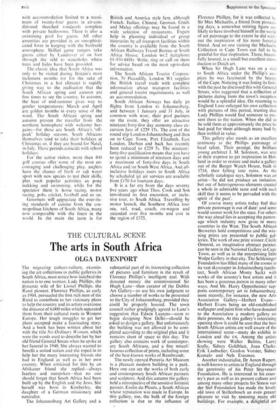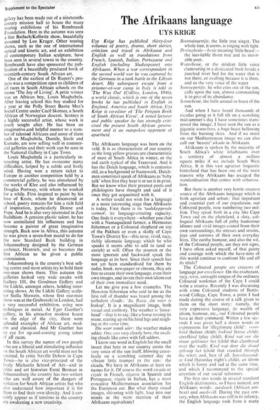THE CULTURAL SCENE
The arts in South. Africa
OLGA DAVENPORT
The migrating culture-vulture, examin- ing the art collections in public galleries in South Africa, must notice how indebted the nation is to one woman, Lady Phillips, the dynamic wife of Sir Lionel Phillips, the Rand pioneer. Florence Phillips, as early as 1904, persuaded the first rich men of the Rand to contribute to her visionary plans to help the country and its artists overcome the distance of 6,000 miles which separated them from their cultural roots in Western Europe. Her tough struggles to get her plans accepted make a fascinating story. And a book has been written about her with the title No Ordinary Woman, which were the words used to describe her by her old friend General Smuts when he spoke at her funeral in 1940. She always wanted to benefit a united nation and she roped in to help her the many interesting friends she had in England as well as in her own country. When criticised for this by an Afrikaner friend she replied—always fearless and outspoken—that no one should forget that South Africa had been built up by the English and the Jews. She herself was born in Kimberley, the daughter of a German missionary and naturalist.
The Johannesburg Art Gallery and a substantial part of its interesting collection of pictures and furniture is the result of Florence Phillips's intelligent zeal. With donated money she commissioned Sir Hugh Lane—then curator of the Dublin Art €allery—to use his own judgment to choose a number of works to be presented to the City of Johannesburg, provided they could be properly housed. The town council rather grudgingly agreed to Lane's suggestion that Edwin Luytens—soon to begin designing New Delhi—should be asked to design a gallery. But unfortunately the building was not allowed to be com- pleted according to the original plan and it remains short of space to this day. The gallery also contains work of contempor- ary South Africans, and a fine miscel:- laneous collection of prints, including some of the best-known works of Rembrandt.
The newly opened Pretoria Art Museum is a pleasant modern building in a park. Here one can see the works of both early and contemporary South African painters and sculptors. And this autumn the gallery held a retrospective of the sensitive Intimist painter, Enslin du Plessis, a South African whose reputation was made in Europe. In this gallery, too, the bulk of the foreign collection is due to the influence of Florence Phillips, for it was collected by Sir Max Michaelis, a friend from pioneer- ing days, a somewhat retiring figure un- likely to have involved himself in the world of art patronage to the extent he did with- out the inspiration of his more forceful friend. And no one visiting the Michaelis Collection in Cape Town can fail to be grateful for that inspiration. There, beauti- fully housed, is a small but excellent intro- duction to Dutch art.
When Sir Hugh Lane was on a visit to South Africa under the Phillip's aus- pices he was fascinated by the beauty of the Cape. Noticing it was losing its links with the past he discussed this with General Smuts, who suggested that a collection of pictures dating from the town's inception would be a splendid idea. On returning to England Lane enlarged his own collection with pictures of this period, trusting that Lady Phillips would find someone to pre- sent them to the nation. When she did so he sold them at approximately the price he had paid for them although many had by then trebled in value.
This gallery also stands as an excellent testimony to the Phillips patronage of local talent. Their protégé, the brilliant young architect J. M. Solomon, was sent at their expense to get inspiration in Hol- land in order to restore and make a gallery out of the Burger Watch House, built in 1716, then falling into ruins. As the scholarly catalogue says, Solomon was an artist—'he did not produce an imitation, but out of heterogeneous elements created a whole in admirable taste and with such skill that it seems to be pervaded with the spirit of the past'.
Of course many artists today feel that private patronage is out of date: and some would sooner work for the state. For others the way ahead lies in accepting the patron- age which industry now gives in many countries in the West. The South African Breweries hold competitions and the win- ning prizes are presented to public gal- leries. The work of one prize winner, Cecile Ormrod, an imaginative abstract painter, can be seen in the National Gallery in Cape Town, as well as in the enterprising little Wolpe Gallery in that city. The Schlesinger Foundation has filled many of the rooms in its vast skyscraper in Johannesburg (archi- tect, South African Monty Sack) with works of the country's best artists and it has been a generous patron in many other ways. And Mr. Harry Oppenheimer sup- ports contemporary art in Johannesburg, most recently, for instance, the new Arts Association Gallery—Herbert Evans— Herbert Evans being an old-established wallpaper and paint firm who have donated to the Association a modern gallery on their premises. At this gallery's interesting opening show it could be seen that the best South African artists are well aware of the international scene—many do exhibit in London and the us. Among the artists showing were Walter Battiss, Larry Scully, Sidney Goldblatt, Joan Clarke. Erik Laubscher, Gordon Vorster, Sidney Kumalo and Nels Erasmus.
Another industrialist, Dr Anton Rupert, is well-known to artists in England through the generosity of his Peter Stuyvesant Foundation. He is interested in his coun- try's past as well as its present culture and among many other projects his Simon van der Stel Foundation has made the lovely old town of Stellenbosch an even greater pleasure to visit by restoring many old buildings. For example, a delightful art gallery has been made out of a nineteenth- century mission hall to house the many touring exhibitions of his Rembrandt Foundation. Here in the autumn was seen a fine Barlach/Kollwitz show, beautifully mounted by Leo Kruger. Other touring shows, such as the one of international optical and kinetic art, and an exhibition of contemporary Italian sculpture, have been seen in several towns in the country. Rembrandt have also sponsored the pub- lication of a beautifully produced book of twentieth-century South African art.
One of the earliest of Dr Rupert's pro- jects was a competition open to children of all races in South African schools on the theme 'The Joy of Living'. A prize winner was an African boy, Louis Maqhubela. After leaving school this boy studied for a year at the Polly Street Bantu Men's Social Centre under Cecil Skotnes, a South African of Norwegian descent. Scotnes is a highly successful artist, whose work is much sought after. He has been an imaginativeand helpful mentor to a num- ber of talented Africans and some of them such as Maqhubela, Dumile, Sitole and Kumalo, are now selling well in commer- cial galleries and their work can be seen in the National Gallery in Cape Town.
Louis Maqhubela is a particularly in- teresting artist. He has overcome many difficulties, helped by a subtle and lively mind. Having won a return ticket to Europe in another competition held by a commercial gallery, be was stimulated by the works of Klee and also influenced by Douglas Portway, with whom he worked for a while. First inspired to paint by his love of Keats, whom he discovered at school, poetry remains for him a rich field of inspiration, particularly Donne and Pope. And he is also very interested inZen Buddhism. A genuine plastic talent, he has now assimilated his influences and has become a painter of great imaginative strength. Back now in Africa, this autumn he was given a seven-foot mural to do for the new Standard Bank building in Johannesburg designed by the German architect, Hentrich, and so becomes the first African to be given a public commission.
Johannesburg is the country's best sell- ing centre and most artists try to hold their one-man shows there. This autumn the galleries looked very wide awake with Gallery 101, the Goodman Gallery and the Lidchi, amongst others, holding inter- esting shows. At the Lidchi Gallery sculp- tor Stella Shawzin, whose first one-man show was at the Grabowski in London, had a very successful exhibition, using new techniques in metal. At Eger Guether's gallery, in his attractive modern house on the edge of the city, there were splendid examples of African art, mod- ern and classical. And Mr Guether has an eye for up-and-coming young talent of all races.
In this survey the names of two people who are a liberal and stimulating influence on the South African art world must not be omitted. In critic Neville Debow in Cape Town—he is also vice-principal of the lively Michaelis School of Art—and in critic and art historian Esine Berman in Johannesburg the country has two writers who are well aware of the dangers of isolation for South African artists but who also understand how important it is for them to find their own identity. And it cer- tainly appear as if tensions in the country are awakening a new creativity.























































 Previous page
Previous page